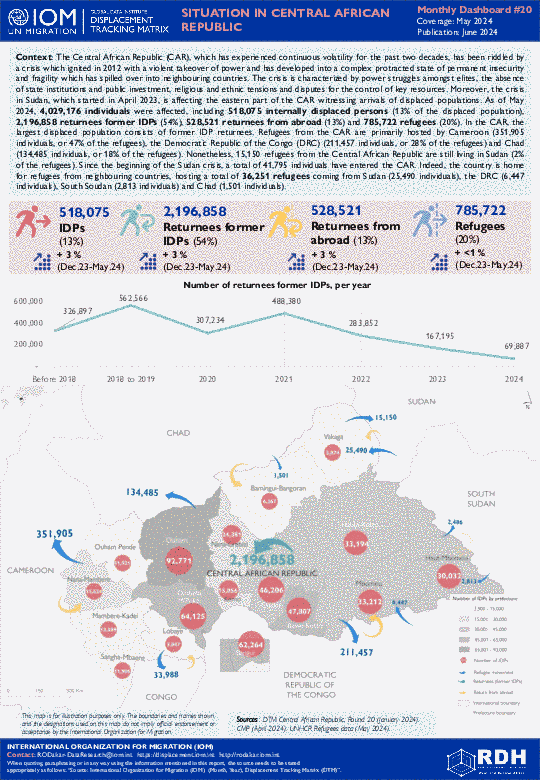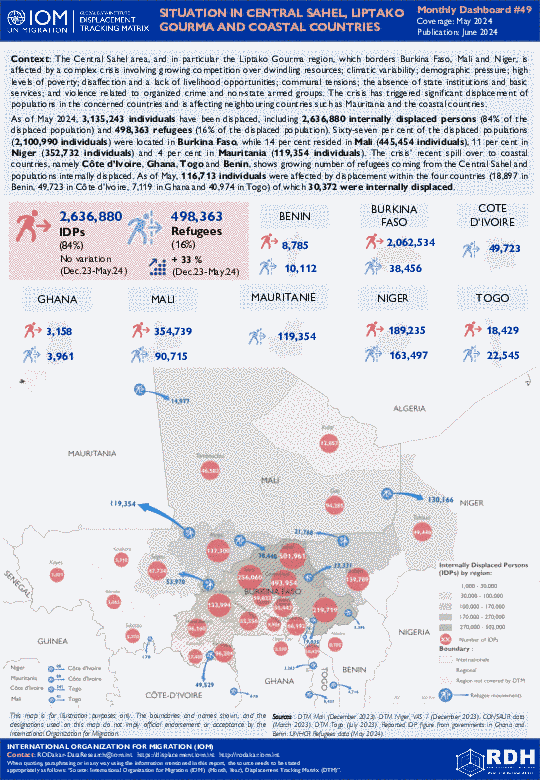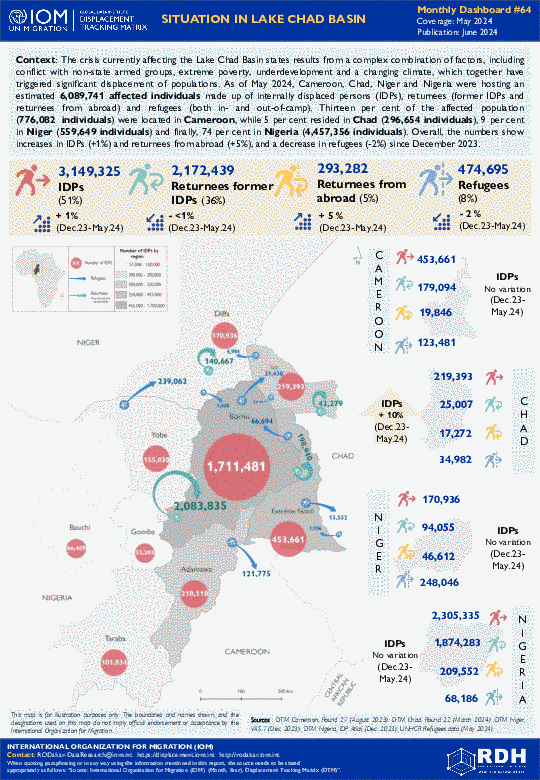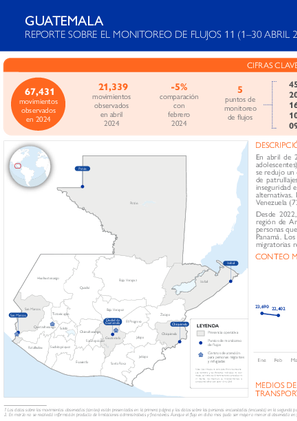-
Countries
-
Data and Analysis
-
Special Focus
-
Crisis Responses
Dashboard/Fact Sheet
Color
-
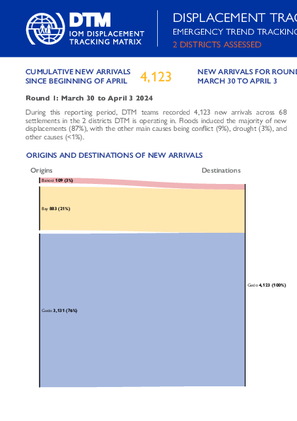
Contact
DTM Somalia, IOMSomaliaDTM@iom.int
Language
English
Location
Somalia
Period Covered
Mar 30 2024
Apr 03 2024
Activity
- Mobility Tracking
- Baseline Assessment
This latest round of Emergency Trends Tracking was initiated in April 2024 to monitor displacements movements during the Gu rainy season. Districts covered in this round include Baardheere and Luuq.
ETT is a crisis-based tool that tracks sudden displacement triggered by specific events or emerging crises. The objective of ETT is to help prioritize humanitarian response and to enable partners to deliver rapid assistance. Based on previous shock induced displacement patterns, the humanitarian community expects that people will continue to move toward urban areas in search of humanitarian services. Consequently, the ETT coverage focuses on the main urban centers and surrounding villages for each assessed district. The data is collected through Key Informant Interviews (KIIs) at the location level, from Sunday to Wednesday every week. It includes information on new arrivals, numbers and demographic of IDPs, reasons for displacement, intentions, humanitarian assistance and priority needs among others. To facilitate the joint analysis of the CCCM (Camp Coordination and Camp Management) Cluster’s New Arrivals Tracker (NAT) and ETT data, the assistance and needs indicators are identical in both tools.
The Central African Republic (CAR), which has experienced continuous volatility for the past two decades, has been riddled by a crisis which ignited in 2012 with a violent takeover of power and has developed into a complex protracted state of permanent insecurity and fragility which has spilled over into neighbouring countries. The crisis is characterized by power struggles amongst elites, the absence of state institutions and public investment, religious and ethnic tensions and disputes for the control of key resources. Moreover, the crisis in Sudan, which started in April 2023, is affecting the eastern part of the CAR witnessing arrivals of displaced populations.
As of May 2024, 4,029,176 individuals were affected, including 518,075 internally displaced persons (13% of the displaced population), 2,196,858 returnees former IDPs (54%), 528,521 returnees from abroad (13%) and 785,722 refugees (20%). In the CAR, the largest displaced population consists of former IDP returnees. Refugees from the CAR are primarily hosted by Cameroon (351,905 individuals, or 47% of the refugees), the Democratic Republic of the Congo (DRC) (211,457 individuals, or 28% of the refugees) and Chad (134,485 individuals, or 18% of the refugees). Nonetheless, 15,150 refugees from the Central African Republic are still living in Sudan (2% of the refugees). Since the beginning of the Sudan crisis, a total of 41,795 individuals have entered the CAR. Indeed, the country is home for refugees from neighbouring countries, hosting a total of 36,251 refugees coming from Sudan (25,490 individuals), the DRC (6,447 individuals), South Soudan (2,813 individuals) and Chad (1,501 individuals).
The Central Sahel area, and in particular the Liptako Gourma region, which borders Burkina Faso, Mali and Niger, is affected by a complex crisis involving growing competition over dwindling resources; climatic variability; demographic pressure; high levels of poverty; disaffection and a lack of livelihood opportunities; communal tensions; the absence of state institutions and basic services; and violence related to organized crime and non-state armed groups. The crisis has triggered significant displacement of populations in the concerned countries and is affecting neighbouring countries such as Mauritania and the coastal countries.
As of May 2024, 3,135,243 individuals have been displaced, including 2,636,880 internally displaced persons (84% of the displaced population) and 498,363 refugees (16% of the displaced population). Sixty-seven per cent of the displaced populations (2,100,990 individuals) were located in Burkina Faso, while 14 per cent resided in Mali (445,454 individuals), 11 per cent in Niger (352,732 individuals) and 4 per cent in Mauritania (119,354 individuals). The crisis’ recent spill over to coastal countries, namely Côte d’Ivoire, Ghana, Togo and Benin, shows growing number of refugees coming from the Central Sahel and populations internally displaced. As of May, 116,713 individuals were affected by displacement within the four countries (18,897 in Benin, 49,723 in Côte d’Ivoire, 7,119 in Ghana and 40,974 in Togo) of which 30,372 were internally displaced.
The crisis currently affecting the Lake Chad Basin states results from a complex combination of factors, including conflict with non-state armed groups, extreme poverty, underdevelopment and a changing climate, which together have triggered significant displacement of populations.
As of May 2024, Cameroon, Chad, Niger and Nigeria were hosting an estimated 6,089,741 affected individuals made up of internally displaced persons (IDPs), returnees (former IDPs and returnees from abroad) and refugees (both in- and out-of-camp). Thirteen per cent of the affected population (776,082 individuals) were located in Cameroon, while 5 per cent resided in Chad (296,654 individuals), 9 per cent in Niger (559,649 individuals) and finally, 74 per cent in Nigeria (4,457,356 individuals). Overall, the numbers show increases in IDPs (+1%) and returnees from abroad (+5%), and a decrease in refugees (-2%) since December 2023.
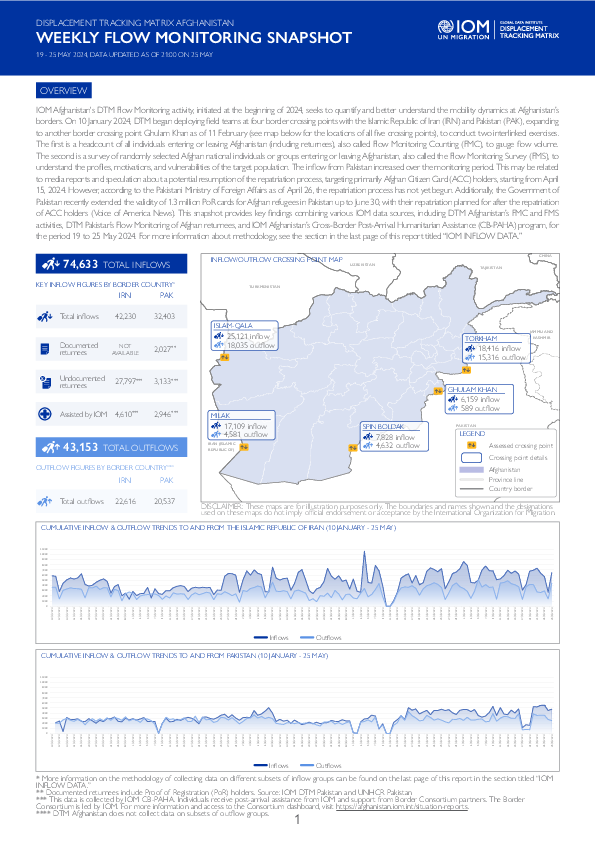
Contact
DTMAfghanistan@iom.int
Language
English
Location
Afghanistan
Period Covered
May 19 2024
May 25 2024
Activity
- Survey
- Flow Monitoring Survey
- Flow Monitoring
IOM Afghanistan's DTM Flow Monitoring activity, initiated at the beginning of 2024, seeks to quantify and better understand the mobility dynamics at Afghanistan’s borders. On 10 January 2024, DTM began deploying field teams at four border crossing points with the Islamic Republic of Iran (IRN) and Pakistan (PAK), expanding to another border crossing point Ghulam Khan as of 11 February (see map below for the locations of all five crossing points), to conduct two interlinked exercises. The first is a headcount of all individuals entering or leaving Afghanistan (including returnees), also called Flow Monitoring Counting (FMC), to gauge flow volume. The second is a survey of randomly selected Afghan national individuals or groups entering or leaving Afghanistan, also called the Flow Monitoring Survey (FMS), to understand the profiles, motivations, and vulnerabilities of the target population. The inflow from Pakistan increased over the monitoring period. This may be related to media reports and speculation about a potential resumption of the repatriation process, targeting primarily Afghan Citizen Card (ACC) holders, starting from April 15, 2024. However, according to the Pakistani Ministry of Foreign Affairs as of April 26, the repatriation process has not yet begun. Additionally, the Government of Pakistan recently extended the validity of 1.3 million PoR cards for Afghan refugees in Pakistan up to June 30, with their repatriation planned for after the repatriation of ACC holders (Voice of America News). This snapshot provides key findings combining various IOM data sources, including DTM Afghanistan’s FMC and FMS activities, DTM Pakistan’s Flow Monitoring of Afghan returnees, and IOM Afghanistan’s Cross-Border Post-Arrival Humanitarian Assistance (CB-PAHA) program, for the period 19 to 25 May 2024. For more information about methodology, see the section in the last page of this report titled “IOM INFLOW DATA.”
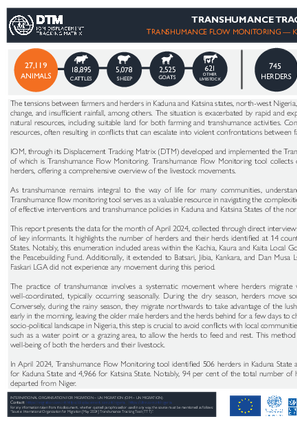
Contact
DTM Nigeria, iomnigeriadtm@iom.int
Language
English
Location
Nigeria
Period Covered
Apr 01 2024
Apr 30 2024
Activity
- Flow Monitoring
This report presents the data for the month of April 2024, collected through direct interviews and direct observation by DTM enumerators and triangulated via a network of key informants. It highlights the number of herders and their herds identified at 14 counting points in 7 Local Government Areas (LGAs) across Kaduna and Katsina States. Notably, this enumeration included areas within the Kachia, Kaura and Kaita Local Government Areas (LGAs) of Kaduna and Katsina states, under the auspices of the Peacebuilding Fund. Additionally, it extended to Batsari, Jibia, Kankara, and Dan Musa LGAs of Katsina state, which were supported by the European Union Fund.
Faskari LGA did not experience any movement during this period.
In April 2024, Transhumance Flow Monitoring tool identified 506 herders in Kaduna State and 239 herders in Katsina State. The animal count was estimated at 22,153 for Kaduna State and 4,966 for Katsina State. Notably, 94 per cent of the total number of herders departed from states within Nigeria, while the remaining 6 per cent departed from Niger.
En abril de 2024 se observaron 21,339 movimientos en Guatemala (16% niños, niñas y adolescentes) y 394 personas fueron encuestadas.1 El número de movimientos observados se redujo un cinco por ciento desde febrero2 de 2024 (22,402). Esto producto del aumento de patrullajes a lo largo de la frontera entre México y Guatemala, así como una mayor inseguridad en algunas partes de Guatemala, lo que empuja a los migrantes a utilizar rutas alternativas. Más de la mitad de los movimientos procedía de la República Bolivariana de Venezuela (72%). El principal destino previsto fue los Estados Unidos de América (91%). Desde 2022, los flujos de migrantes en tránsito incrementaron significativamente en la región de América Latina y el Caribe, observando cantidades nunca antes registradas de personas que cruzan la peligrosa selva del Parque Nacional del Darién desde Colombia hacia Panamá. Los flujos en tránsito observados en Guatemala han reflejado dichas tendencias migratorias regionales.

Contact
iomguatemala@iom.int
Language
English
Location
Guatemala
Period Covered
Apr 01 2024
Apr 30 2024
Activity
- Flow Monitoring
In April 2024, 21,339 movements were observed in Guatemala (16% children) and 394 individuals were surveyed.1 The number of observed movements decreased by five per cent from February2 2024 (22,402). This is a result of the increase in patrols along the Mexico–Guatemala border as well as increased insecurity in some parts of Guatemala, pushing migrants to use alternative routes.More than half of movements originated from the Bolivarian Republic of Venezuela (72%). The main intended destination was the United States of America (91%). Since 2022, migratory flows through the Latin America and Caribbean region have increased significantly, with record levels of persons crossing the perilous jungle of the Darién National Park from Colombia into Panama. The in-transit flows tracked in Guatemala have mirrored these regional migration trends.
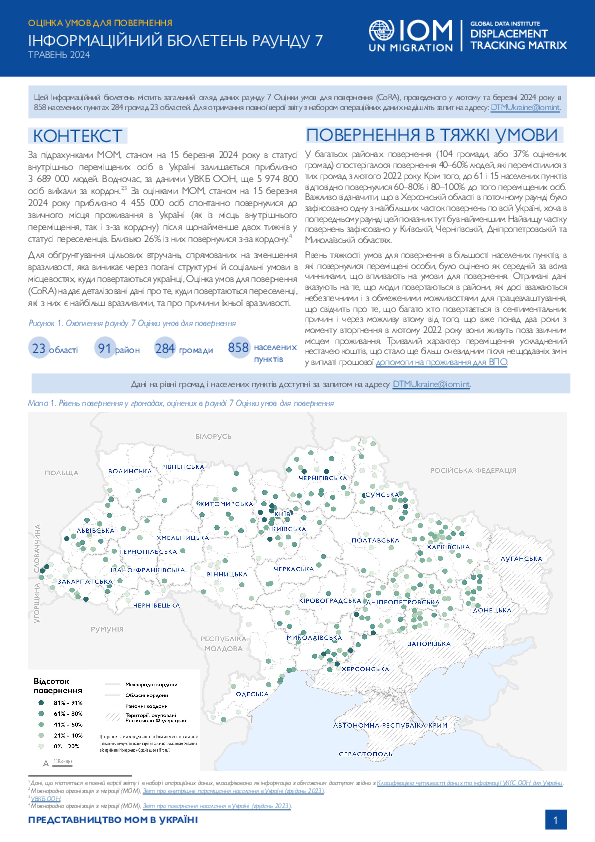
Contact
DTMUkraine@iom.int
Language
English
Location
Ukraine
Period Covered
Feb 01 2024
Mar 15 2024
Activity
- Return Intention
- Mobility Tracking
За оцінками МОМ, станом на 15 березня 2024 року близько 3 689 000 осіб залишалися внутрішньо переміщеними особами в Україні, тоді як УВКБ ООН зазначає, що ще 5 930 400 осіб були переміщені за кордон. За оцінками МОМ, станом на 15 березня 2024 року приблизно 4 455 000 осіб спонтанно повернулися до місць свого постійного проживання в Україні після періоду переміщення тривалістю щонайменше два тижні (внутрішнє переміщення або переміщення за кордон). З них 26% повернулися з-за кордону.
Для обґрунтування цільових втручань, спрямованих на зменшення вразливості, зумовленої поганими структурними та соціальними умовами в місцях повернення, Оцінка умов повернення (CoRA) надає детальні дані про те, де відбуваються повернення, яким чином ті, хто повернувся, є найбільш вразливими і чому.
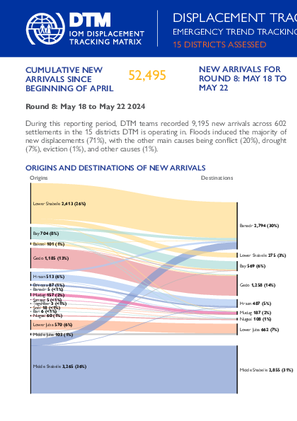
Contact
DTM Somalia, IOMSomaliaDTM@iom.int
Language
English
Location
Somalia
Period Covered
May 18 2024
May 22 2024
Activity
- Mobility Tracking
- Baseline Assessment
This latest round of Emergency Trends Tracking was initiated in April 2024 to monitor displacements movements during the Gu rainy season. Districts covered in this round include Afgooye, Afmadow, Baardheere, Baidoa, Balcad, Belet Weyne, Gaalkacyo, Garoowe, Jamaame, Jowhar, Kismaayo, and Luuq.
ETT is a crisis-based tool that tracks sudden displacement triggered by specific events or emerging crises. The objective of ETT is to help prioritize humanitarian response and to enable partners to deliver rapid assistance. Based on previous shock induced displacement patterns, the humanitarian community expects that people will continue to move toward urban areas in search of humanitarian services. Consequently, the ETT coverage focuses on the main urban centers and surrounding villages for each assessed district. The data is collected through Key Informant Interviews (KIIs) at the location level, from Sunday to Wednesday every week. It includes information on new arrivals, numbers and demographic of IDPs, reasons for displacement, intentions, humanitarian assistance and priority needs among others.
Pagination
- Previous page
- Page 9
- Next page
